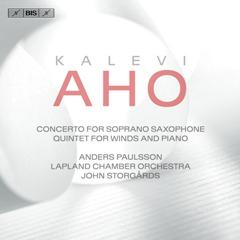Kalevi Aho: Concerto For Soprano Saxophone - Quintet For Winds And Piano (2017)
Kalevi Aho: Concerto For Soprano Saxophone - Quintet For Winds And Piano (2017)

Concerto for Soprano Saxophone and Chamber Orchestra (2014–15) (23:34) 1 I. Invocatio– Presto–Cadenza 11:47 2 II. Misterioso, largo 4:4 3 III. Allegretto marcato – Presto– Quasi epilog 6:58 Quintet for oboe, clarinet, bassoon, horn and piano (2013) (24:20) 4 I. Tranquillo – Allegretto ondeggiante 9:04 5 II. Toccata 4:39 6 III. Nocturno 5:42 7 IV. Burlesco 4:46 8 Solo I for violin (1975) 9:46 Sopranino Saxophone – Anders Paulsson Jaakko Kuusisto - Violin Antal Mojzer - Bassoon Pekka Niskanen - Clarinet Ilkka Puputti - Horn Markku Moilanen 0 Oboe Väinö Jalkanen - Piano Lapland Chamber Orchestra John Storgårds - Conductor
The BIS label is to be commended on its continuing support for Finnish composer Kalevi Aho’s consistently well-crafted and often inspiring output. A search of this site will reveal quite a considerable catalogue of works in a variety of instrumental genres, and Dan Morgan’s survey of his music.
The Saxophone Concerto was written for soloist Anders Paulsson and commissioned by the Lapland Chamber Orchestra. Paulsson had heard and liked Aho’s Clarinet Concerto (review), and after suggesting a new work for soprano saxophone and strings the work was completed within two months. The opening to the first movement is a lyrical and ruminating Invocatio that eventually resolves into a virtuoso Presto. Aho’s restless creativity to me often suggests a dramatic narrative of some kind, and this is the case here, the soloist at times heroically riding the orchestra as if it were a rather discomforting means of transport, at others leading it into or away from danger. A dark tranquility is reached towards the end of the movement, over which the soloist explores multiphonics in an intriguing cadenza. The Misterioso second movement lays down a quiet and atmospheric bed of sustained strings over which the saxophone weaves a quasi-improvisatory ‘never-ending’ melody that uses unearthly microtonal intervals. After a little surprise coda to this slow movement, the ritualistic march with the strings ‘knocking’ col-legno suggests a slow march into which the free spirit of the slow movement is now imprisoned. Aho winds up the tension gradually, the high notes of the saxophone eventually rising above the strings, who retreat. An urgent but secretively quiet Presto section follows, and the last two minutes or so disperse into a Quasi epilogo in which elements of preceding material and performance techniques are further transformed, the end giving the impression that the music continues underground somewhere; unheard, but like the invisible spectrum of light, full of boundless resource.
The Quintet for four wind instruments and piano was written to share a programme with Mozart’s quintet for the same setting. Conventional in concept, this is well crafted music that makes the most of a challenging instrumentation. The first movement is the most substantial, Aho describing it as “lyrical, slightly melancholy… the central part of the movement [rising] to a powerful climax.” The second movement is a fast toccata, with the winds stabbing and winding around a virtuoso piano part with plenty of repeated notes and dramatic rhythms. A quiet Nocturno follows, the dreamy atmosphere of which is also not safe from the occasional moment of drama. Aho applies the word “mischievous” to the finale, which surfs on potent rhythms that sometimes hint at Stravinsky. “At the end, the tempo increases as much as possible.”
Solo I for violin is a much earlier piece. The violin is Aho’s own main instrument, and this technical familiarity resulted in something so virtuosic that the work waited 11 years for its first performance. It became the launch for a series of solo works, the composer’s lifelong project being to create solo works for all of the main orchestral instruments and beyond, all exploring each instruments’ capabilities. Solo I makes considerable use of double-stopping, and indeed puts both player and instrument to its limits. Plaudits go to Jakko Kuusisto for a recording that retains musicality and wit to go along with these stresses. His album Glow on BIS-2192 is also worth exploring (review).
With BIS’s usual high recording standard and another intriguing programme of worth and substance from Kalevi Aho’s pen, this is another good one to add to your contemporary music collection. If you are new to this composer then you might prefer to start with the symphonies, but this rather mixed bag of works can also serve as an introduction, especially the rather special Concerto for Soprano Saxophone and Chamber Orchestra. --- Dominy Clements, musicweb-international.com
download (mp3 @320 kbs):








